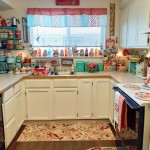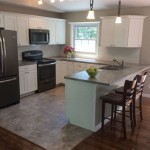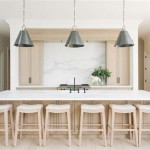Kitchen Cabinets With Pocket Doors: A Space-Saving and Stylish Solution
Kitchen cabinets with pocket doors offer a unique blend of functionality and aesthetics, providing a practical solution for maximizing space and concealing appliances or storage areas. Unlike traditional hinged doors that swing outward, pocket doors slide horizontally into a recessed compartment within the cabinet frame, effectively disappearing when opened. This feature is particularly valuable in smaller kitchens or areas where maximizing movement is crucial. This article will explore the benefits, design considerations, installation aspects, and maintenance requirements associated with kitchen cabinets featuring pocket doors.
The core concept behind pocket doors lies in their space-saving design. Hinged cabinet doors require clearance to swing open, which can obstruct walkways, interfere with adjacent cabinets, or limit movement within the kitchen. Pocket doors eliminate this issue by retracting flush with the cabinet face. This characteristic makes them ideal for galley kitchens, compact apartments, or any situation where optimizing the available footprint is a priority. Beyond space efficiency, pocket doors can contribute to a cleaner, more streamlined aesthetic. By concealing appliances, small pantries, or even cookware, pocket doors help to achieve a minimalist and organized kitchen environment. The visual simplicity they offer can dramatically impact the overall design, lending a sense of openness and sophistication.
Pocket doors also offer versatility in their application. They can be used to conceal a variety of kitchen elements, from small appliances like toasters and blenders to larger appliances like microwaves or coffee makers. They can also be used to create hidden pantry areas or to conceal areas with open shelving that might otherwise appear cluttered. The ability to hide these elements when not in use keeps the kitchen looking tidy and well-organized. Furthermore, pocket doors can be incorporated into various cabinet styles, from modern and contemporary designs to more traditional or farmhouse aesthetics. The door panel itself can be customized with different materials, finishes, and hardware to complement the overall kitchen décor.
Space Optimization and Enhanced Functionality
The primary advantage of kitchen cabinets with pocket doors is undoubtedly their ability to optimize space within the kitchen. The absence of swinging doors provides greater freedom of movement and reduces the risk of accidental collisions. In confined kitchens, this can be a significant improvement, allowing for easier navigation and more efficient use of the workspace. Pocket doors are particularly useful in areas where multiple people may be working in the kitchen simultaneously. The reduced obstruction allows for greater flexibility and cooperation, minimizing the potential for disruption and maximizing productivity.
Beyond simply saving space, pocket doors enhance the functionality of the kitchen by providing convenient access to concealed storage areas or appliances. When needed, the door can be quickly and easily retracted, revealing the contents of the cabinet. When not in use, the door can be closed to create a clean and uncluttered appearance. This versatility makes pocket doors a valuable addition to any kitchen. Consider, for instance, a cabinet designed to house a coffee station. The pocket door can conceal the coffee maker, grinder, and other accessories when not in use, creating a more streamlined and organized look. When it's time to make coffee, the door can simply be slid open for immediate access.
Furthermore, pocket doors can be integrated with other space-saving features, such as pull-out shelves or rotating organizers, to maximize storage capacity and improve accessibility. This combination of features can transform even the smallest kitchen into a highly functional and efficient workspace. The possibilities for customization are virtually endless, allowing homeowners to tailor their kitchens to their specific needs and preferences.
Design Considerations for Pocket Door Cabinets
When incorporating pocket doors into kitchen cabinet design, several factors merit careful consideration. These include the size and weight of the door, the type of hardware used, the construction of the cabinet frame, and the overall aesthetic of the kitchen. The size and weight of the door will influence the selection of hardware and the strength of the cabinet frame. Larger, heavier doors will require more robust hardware and a sturdier frame to ensure smooth and reliable operation. The type of hardware used can also impact the overall look and feel of the cabinet. There are various options available, ranging from simple and functional to more decorative and ornate.
The construction of the cabinet frame is another critical consideration. The frame must be strong enough to support the weight of the door and withstand the forces exerted during opening and closing. It should also be designed to accommodate the pocket into which the door will retract. The pocket should be properly sized and positioned to ensure that the door slides smoothly and without binding. The choice of materials for the cabinet frame will also affect its durability and longevity. Solid wood frames are generally the strongest and most durable, but they can also be the most expensive. Plywood or particleboard frames are less expensive but may not be as strong or durable. The overall aesthetic of the kitchen should also be taken into account when selecting pocket doors. The door panel can be customized with different materials, finishes, and hardware to complement the existing décor. For example, a contemporary kitchen might benefit from sleek, minimalist pocket doors with stainless steel hardware, while a traditional kitchen might be better suited to more ornate doors with wooden panels and antique brass hardware.
Lighting is an often overlooked aspect of cabinet design with pocket doors. Since the pocket door can conceal the interior cabinet space entirely, adequate lighting within the cabinet is essential. Incorporating LED strip lights or in-cabinet lighting solutions can significantly improve visibility and functionality. This is particularly important for cabinets that house appliances or frequently used items. Finally, it is important to consider the surrounding environment. The placement of electrical outlets, plumbing fixtures, and other obstructions should be taken into account when designing the pocket door. The goal is to create a seamless and functional design that integrates seamlessly with the existing kitchen layout.
Installation and Maintenance of Pocket Door Cabinets
The installation of kitchen cabinets with pocket doors is generally more complex than the installation of standard hinged cabinets. Because the system requires precise alignment and integration, professional installation is highly recommended. The installation process typically involves several steps, including preparing the cabinet frame, installing the pocket door hardware, and fitting the door panel. The cabinet frame must be carefully constructed to ensure that the pocket is properly sized and positioned. The pocket door hardware must be securely attached to the frame and aligned correctly to ensure smooth and reliable operation.
The door panel must be carefully fitted to the frame and adjusted to ensure that it slides smoothly and without binding. The installer must also ensure that the door is properly aligned and that it closes flush with the cabinet face. This requires a high degree of precision and attention to detail. After installation, regular maintenance is essential to ensure that the pocket doors continue to function smoothly and reliably. This maintenance typically involves cleaning the tracks and rollers, lubricating the hardware, and inspecting the door for any signs of damage or wear. The tracks and rollers should be cleaned regularly to remove any dirt, dust, or debris that could impede the movement of the door. A vacuum cleaner with a brush attachment can be used to clean the tracks, and a damp cloth can be used to wipe down the rollers.
The hardware should be lubricated periodically with a silicone-based lubricant to ensure smooth and quiet operation. Avoid using oil-based lubricants, as they can attract dust and dirt, which can eventually clog the mechanism. The door should be inspected regularly for any signs of damage or wear, such as cracks, splinters, or loose hardware. Any damage should be repaired promptly to prevent further deterioration. Over time, the door may need to be adjusted to ensure that it continues to close flush with the cabinet face. This can be done by loosening the screws on the hinges and adjusting the position of the door. In summary, while the initial investment in pocket door cabinetry may be higher and the installation more intricate, the long-term benefits of space optimization and enhanced functionality, combined with proper maintenance, make it a worthwhile consideration for many kitchen designs.

Cabinet Pocket Doors General Q A Chieftalk Forum

How Pocket Doors Can Save Your Space With Style Dodi Custom Kitchen Cabinets

Kitchen S Part 1 Pantry Doors Am Singer Design

Medallion Cabinetry Bake Center With Pocket Doors

Pocket Doors How To Use Them In Your Kitchen Or Bathroom

Pocket Door Appliance Center With Internal Cabinets For Conceal Items Modern Kitchen Other By Christine Lakas The Designer Llc Houzz Ie

Kitchen Appliance Cupboard Ideas Making Your Home Beautiful

Pocket Door Larder Cupboards This Beautiful Kitchen Had Space For 2 Larders So We Gave Each One It S Own Job Dried Food And The

Kitchen Cabinet Pocket Doors Design Ideas

Cabinet Pocket Doors General Q A Chieftalk Forum








